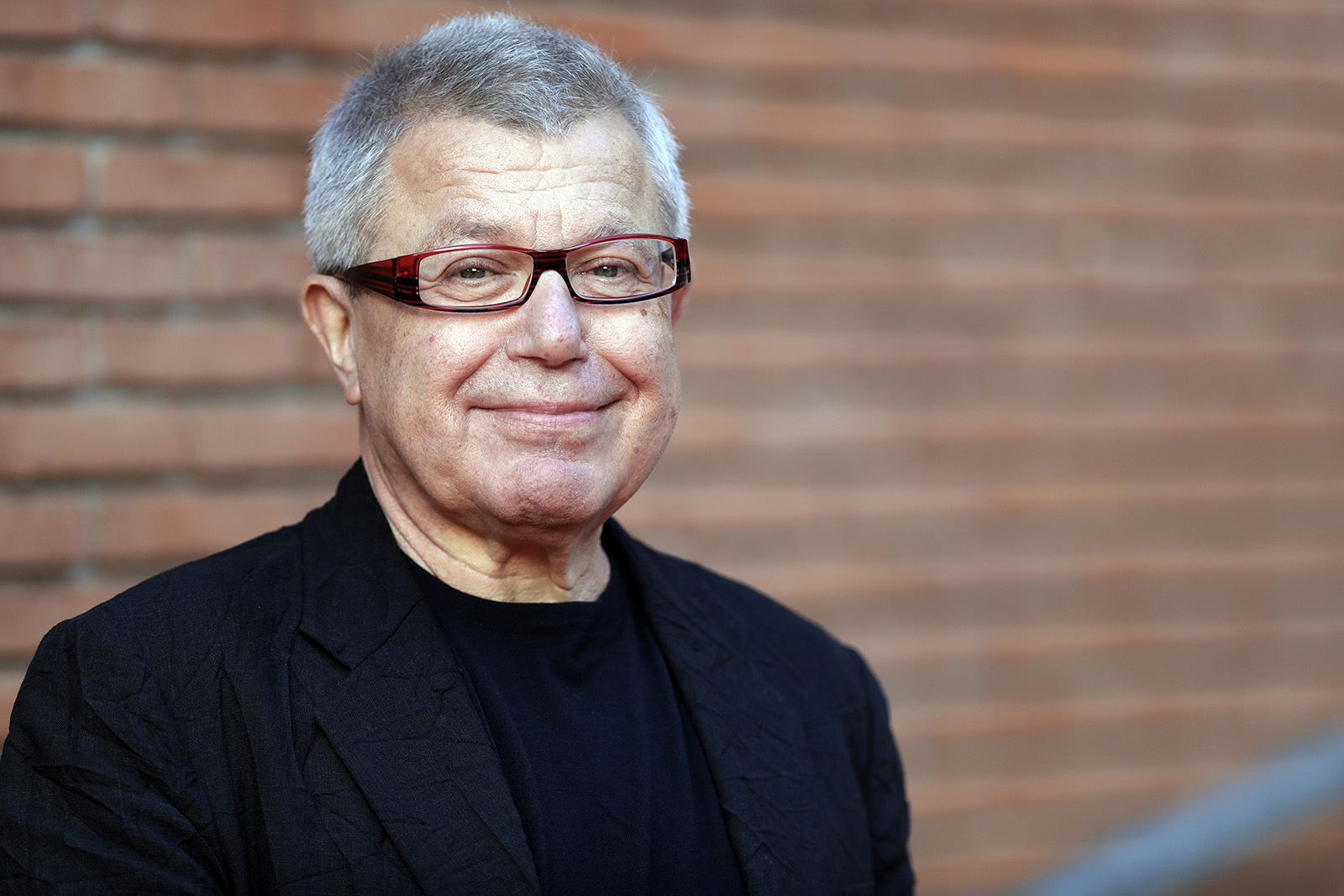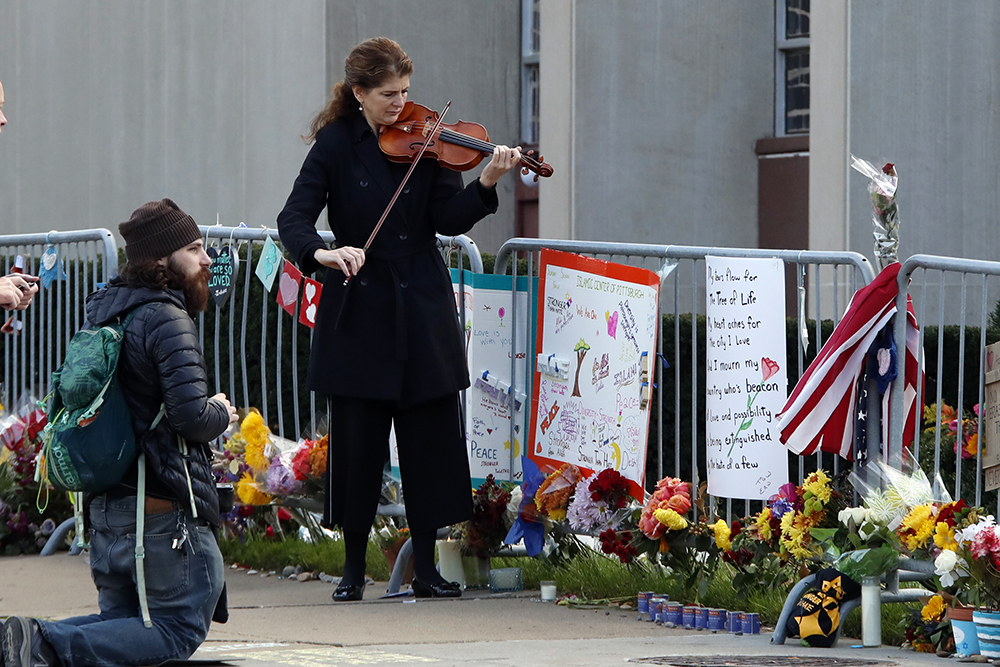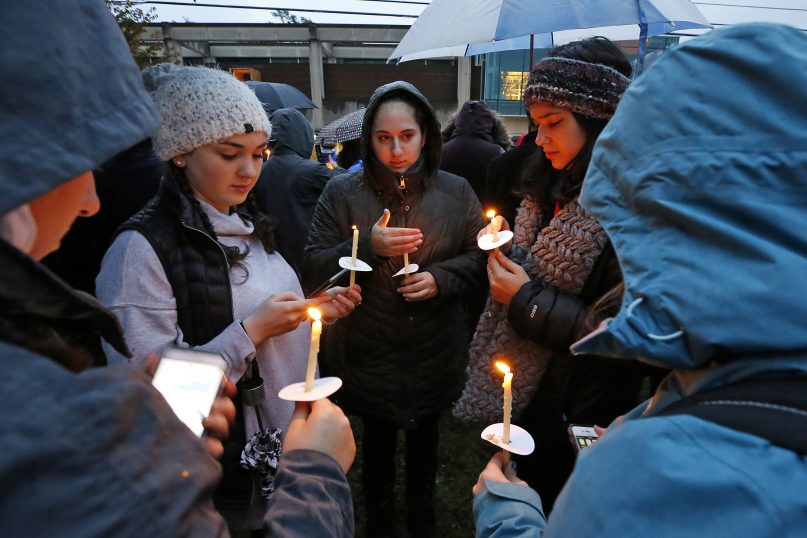(RNS) — The site of the most deadly attack on Jews in U.S. history is getting ready to rebuild.
In early May, the Tree of Life synagogue in Pittsburgh announced that Daniel Libeskind, the architect of Berlin’s Jewish Museum and the master planner of the World Trade Center district after 9/11, had been commissioned to redesign Tree of Life as a worship space that would share space with the Holocaust Center of Pittsburgh as well as a Hall of Memories about the attack.
After his first visit to the site, Libeskind told the Pittsburgh Jewish Chronicle that his goal is to “affirm life, but also address what happened, why we are building a new building in the first place.” He added, “This is a place where Jews were murdered because they were Jews, because they were praying in a synagogue,” and continued: “This is not just local. This is a project that should touch everyone’s heart.”
Libeskind stated that he hopes to achieve these objectives “through light, acoustics and the materials used.”
RELATED: Tree of Life names renowned architect Daniel Libeskind to design synagogue complex
As a member of New Light, one of the congregations that rented space at Tree of Life at the time of the shooting though we do not expect to return, I’ve been thinking deeply about what messages I’d like those visiting the space to come away with. I have a few ideas for Libeskind — not design ideas; that’s not my field. But here are a few things Libeskind might keep in mind as he goes about his work.

Architect Daniel Libeskind in Rome on Oct. 21, 2016. (AP Photo/Andrew Medichini)
Several months after the shooting, in an attempt to make sense of what had happened and begin to think to the future, I sat down with Eric Lidji, director of the Rauh Jewish History Program & Archives at the Senator John Heinz History Center in Pittsburgh, and historian of memory James Young, who directs the Institute for Holocaust, Genocide and Memory Studies at the University of Massachusetts Amherst.
Before a memorial can be created, Young said, the meaning of the event has to coalesce. Was the shooting about antisemitism, gun violence, the importance of study and worship on the Jewish Sabbath, or the place of Jews in America? Is this an upending of the expected, that we are safe here, or is it a continuation of centuries of Jew hatred that we have faced in every community in which we live?
Should we recall the aftermath of the violence — an outpouring of support from both the non- Jewish community here in Pittsburgh, with clergy of every possible denomination who came to a public memorial service the day after the shooting, and from Jews around the world?
This past week Jews observed Tisha B’Av, the day on which Jews commemorate the destruction of both ancient temples in Jerusalem and the many other calamities to have befallen us. It is the heaviest of days, when we contemplate the weight of history and the improbable survival of our people. In the 19th kinah of the liturgical poems of lamentation we recite on Tisha B’av, we say “anu kiyamim” — “We have survived.”
The rabbi at the synagogue I was attending suggested that as part of our observation of the holiday, we go ourselves to the Tree of Life site.
Unsure, I later walked alone the few short blocks along Shady Avenue. It was odd to stand there at a place so focused on community with no one beside me. One teaching I learned this week is that once the burning of the temple commenced, God decided that the building would be destroyed but the Jewish people would be saved. At Tree of Life, I thought, it was the people who were killed and scattered and the building that was saved.
One of the main goals of Tisha B’av, as Yael Ziegler explains in her recent commentary on the Book of Lamentations, is to remind us to act as a collective, to see ourselves as a united community. That movement from the individual to the communal should be an integral idea in a new Tree of Life. From Shady Avenue, I walked around the corner to look at the objects collected in a gallery inside the building visible from the outside. So many messages and objects, from the 11 glass flowers — one for each shooting victim — blooming constantly to the crocheted Jewish stars with hearts in them placed there and elsewhere around the neighborhood, to the white wooden Jewish stars placed by Greg Zanis, who before his death last year would go to sites of mass violence to honor the victims.

Monique Mead plays her violin on the sidewalk outside the Tree of Life synagogue in Pittsburgh on Oct. 27, 2019, the first anniversary of the shooting at the synagogue that killed 11 worshippers. (AP Photo/Gene J. Puskar)
The Book of Exodus tells us that in building the tabernacle in the desert, all the people gave in some way, directed by Bezalel, the craftsperson and visionary who adapted the plans at Moses’ direction.
This is what I want for the new Tree of Life, and this is the meaning of what happened: a testament to the survival of a community; the determination and love for Judaism of all three of the synagogues that worshipped in the space, and those continuing to worship there; the sense of defiance that all of Squirrel Hill, not just Jews, showed to deflect the shooter’s hate.
RELATED: The Jewish answer to how to punish the Pittsburgh synagogue shooter
Across the street from Tree of Life is the Children’s Institute of Pittsburgh. Its motto? “To Heal. To Teach. To Empower. To Amaze.”
That seems like a pretty good guide for Daniel Libeskind. The new Tree of Life should heal those in the community and those who visit. It should teach them what Judaism is and why Jews are willing to be martyrs for it. The structure should empower visitors to fight hatred of all kinds, not just against Jews but all types of intolerance. Finally, amaze with what can be done by a master architect like yourself.
A tall order, but then that is why you were hired. I look forward to seeing your design and the final work, hoping that it helps our community to continue to cope with the trauma we have experienced, to heal and to honor the memories of those who were slain.
(Beth Kissileff, a journalist in Pittsburgh, is co-editor of the 2020 book “Bound in the Bond of Life: Pittsburgh Writers Reflect on the Tree of Life Tragedy” and editor of the forthcoming “Reading Exodus: Journeys.” The views expressed in this commentary do not necessarily reflect those of Religion News Service.)





